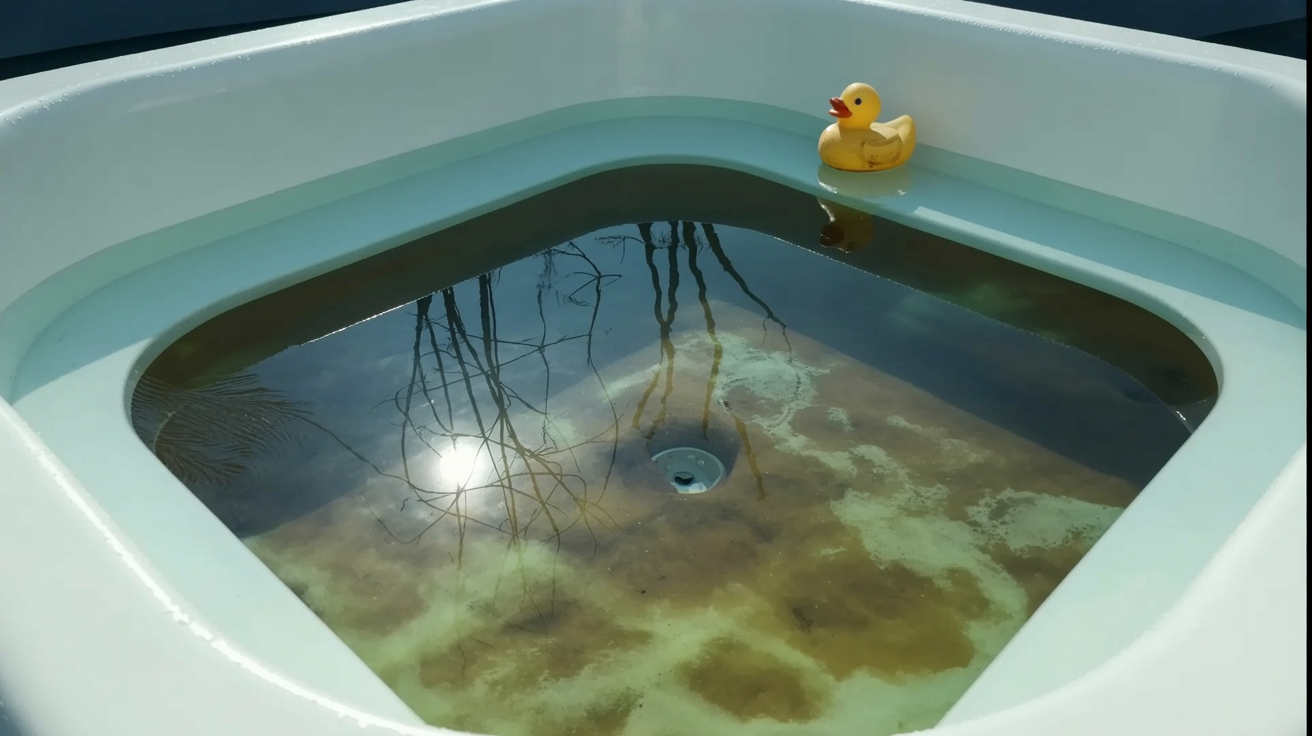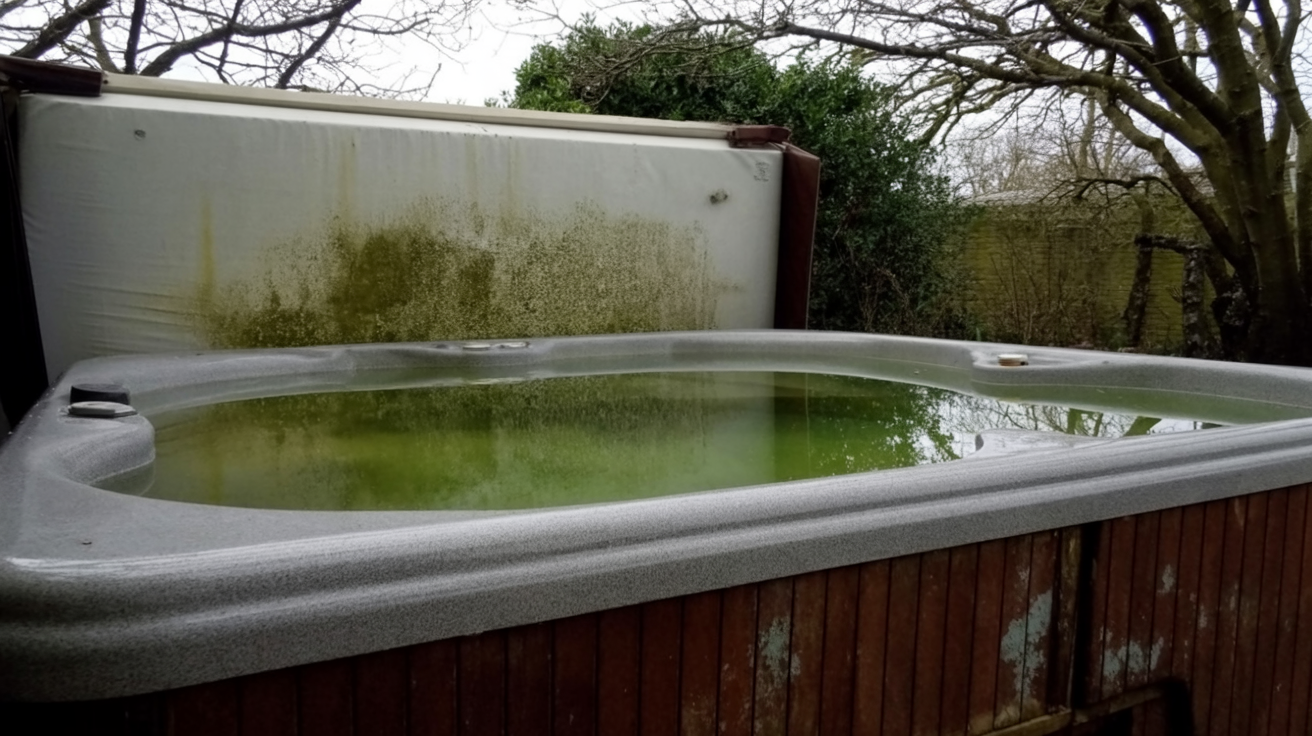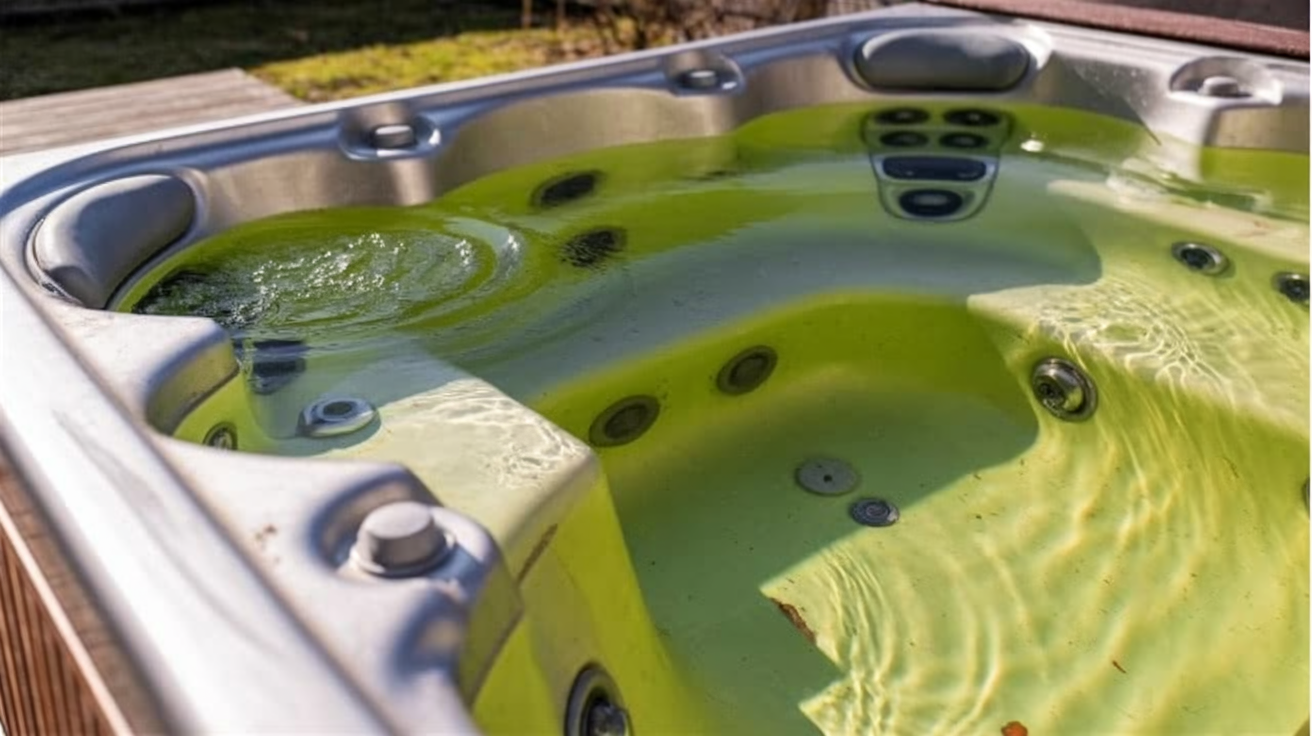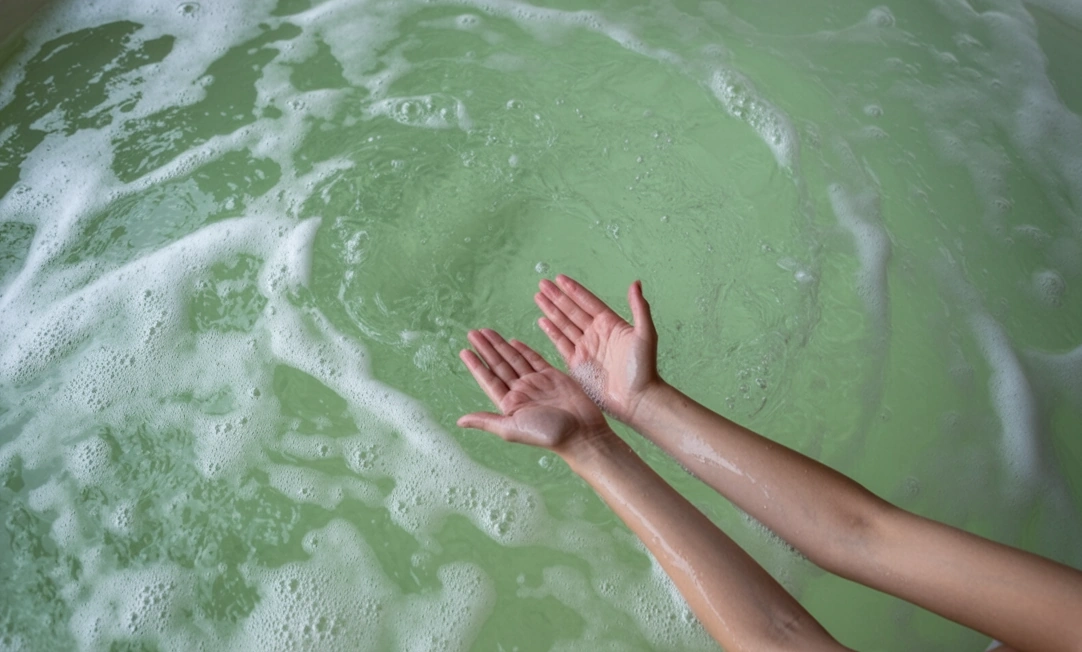At the hot tub chemical store it’s not uncommon to see a lot of algaecides that remove algae from spa water. But you may be wondering “do I need to put algaecide in my hot tub?”
Most hot tub owners don’t need regular algaecide if they maintain proper sanitizer levels and water chemistry and regularly keep their hot tub covered when not in use.
Green water in your hot tub can be alarming for any spa owner. You might wonder if adding algaecide is the solution to your algae problems.
Many hot tub owners assume they need special chemicals to prevent algae growth. However, the truth about algaecide and spa water might surprise you.
Proper water chemistry and sanitizer levels are usually enough to keep your hot tub clean. But certain situations make algaecide a useful tool in your maintenance arsenal.
This guide will help you understand when algaecide is necessary and when it’s just an extra expense. We’ll cover the best way to prevent green algae without relying on unnecessary hot tub chemicals.
You’ll learn how proper circulation, balanced water chemistry, and regular shock treatment can keep your spa crystal clear. By the end, you’ll know exactly whether your hot tub needs algaecide or if simpler solutions will work better.
Ready to Spend Less Time On Maintenance and More Time Enjoying Your Hot Tub?
Let’s face it. Balancing the water, cleaning filters, dealing with rashes, and trying to figure out which chemicals to buy and add can make you feel more like a chemist than someone who just wants to relax after a long hard day!
That’s exactly why The Hot Tub Handbook and Video Course is so valuable!
This is from Matt over at Swim University and he developed it for people looking to save money, time, and frustration. His tips on chemicals can save you $100/year just by making sure you buy only what you need.
So if you’re ready to stop being confused or frustrated with your hot tub and start spending more time in it, check out The Hot Tub Handbook and Video Course.
Just click that link to learn more on their website.
Can Algae Grow in a Hot Tub?
Yes, algae can definitely grow in hot tubs, though it’s less common than in swimming pools. The warm water environment creates ideal conditions for algae growth when water chemistry becomes unbalanced.
Green algae is the most common type of algae found in spa water, turning your hot tub water an unsightly green color. Black algae and mustard algae can also develop, though they’re rarer in hot tub environments.
Several factors contribute to algae problems in hot tubs. Low sanitizer levels, poor circulation, dirty filters, and high pH all encourage algae growth. Direct sunlight and stagnant water also create perfect breeding conditions for these organisms.
Hot tub owners often notice algae blooms when chlorine levels drop below the recommended range. Organic contaminants from body oils and organic matter provide nutrients that feed algae growth.
How to Prevent Algae in a Hot Tub
The best way to prevent algae growth is to maintain proper sanitizer levels in your spa water. Keep chlorine levels between 1-3 ppm or bromine at 3-5 ppm using test strips to monitor chemical balance regularly.
Proper circulation is essential for algae prevention. Run your circulation system daily to keep water moving and prevent stagnant water conditions that encourage algae growth.
Balance your water chemistry by maintaining total alkalinity between 80-120 ppm and pH in the recommended range of 7.2-7.8. High pH creates ideal conditions for algae blooms, so use pH decreaser when levels climb too high.
Clean or replace your filters regularly since a dirty filter reduces water quality and allows organic contaminants to accumulate. These organic materials feed algae and contribute to water problems.
Weekly shock treatment eliminates organic matter and body oils that provide nutrients for algae. Use either chlorine-based shock or non-chlorine shock following manufacturer’s instructions.
Keep your hot tub covered when not in use to limit direct sunlight exposure. UV light promotes algae growth and reduces sanitizer effectiveness.
What Will Kill Algae in a Hot Tub?
Chlorine is the most effective weapon against algae in hot tub water. Raise your chlorine levels to 5-10 ppm temporarily to kill existing green algae – much higher than normal sanitizer levels but necessary for algae elimination.
Shock treatment provides another powerful method for destroying algae blooms. Use double or triple the normal shock dose following the manufacturer’s instructions to oxidize algae and organic matter feeding the outbreak.
Algaecide specifically targets different types of algae when chlorine alone isn’t sufficient. Choose copper-based algaecides for green algae or quaternary ammonium compounds for black algae and mustard algae varieties.
Scrubbing surfaces manually removes stubborn algae that chemicals can’t reach. Brush all spa surfaces thoroughly, then vacuum dead algae debris to prevent it from decomposing and creating more organic contaminants.
For severe algae outbreaks, drain and refill your spa with fresh water. This nuclear option eliminates all algae and contaminated water chemistry in one step.
Always test your spa water with test strips after chemical treatment to ensure chlorine levels return to the recommended range before soaking. High chemical concentrations can cause serious skin irritation until levels normalize.
Will Shock Kill Algae in a Hot Tub?
Yes, shock treatment can kill algae in hot tubs, but its effectiveness depends on the type of algae and severity of the algae bloom. Chlorine-based shock works best against green algae by oxidizing the organisms and destroying their cellular structure.
For minor algae growth, a double dose of shock treatment often eliminates the problem within 24 hours. However, stubborn black algae or mustard algae may require multiple shock treatments combined with manual scrubbing.
Non-chlorine shock has limited effectiveness against live algae since it doesn’t contain sanitizing agents. While it oxidizes organic matter that feeds algae growth, it won’t directly kill existing algae organisms in your spa water.
The key is using enough shock to overwhelm the algae’s defenses. Follow manufacturer’s instructions but consider doubling the recommended dose for active algae outbreaks. Test your water chemistry with test strips before and after treatment to monitor chlorine levels.
Shock works best when water chemistry is properly balanced. High pH reduces shock effectiveness, so adjust pH to the recommended range first using pH decreaser if necessary.
For severe algae problems, shock treatment alone may not be sufficient, requiring additional chemical treatment or algaecide for complete elimination.
What is the Best Algaecide for Hot Tubs?
If you find yourself in a situation with algae in your hot tub, I love the Regal Algaecide 60 on Amazon.
It’s the highest rated algaecide on Amazon, and formulated specifically for both hot tubs and pools (some are mostly for pools, which often have different needs.
CLICK HERE to check the current price on Amazon.
Why is My Hot Tub Water Green but Not Algae?
Green water in your hot tub doesn’t always mean algae growth – several other factors can cause this discoloration. Copper contamination is the most common culprit, creating green hot tub water that looks exactly like an algae bloom.
High copper levels occur when your water chemistry becomes unbalanced, particularly with low pH levels. Acidic spa water dissolves copper from heating elements, plumbing, or heat exchangers, turning your water green overnight.
Metal staining from iron or manganese can also create greenish discoloration. Well water often contains these minerals, which become visible when chlorine levels oxidize the metals in your spa water.
Use test strips or a liquid test kit to check your water chemistry first. If pH is below the recommended range, copper dissolution is likely the cause rather than algae.
To get rid of the high mineral levels in your hot tub’s water, I love Metal Gon from Leisure Time!
It’s cheap, works great, has great reviews, and once you treat the water, you’ll never need to add it again until you change your water.
CLICK HERE to check the current price on Amazon.
Unlike algae problems, metal-related green water won’t respond to shock treatment or algaecide. Instead, focus on balancing total alkalinity and pH levels, then consider using a metal sequestrant to bind dissolved metals and restore water clarity.
Final Thoughts
Most hot tub owners don’t need algaecide if they maintain proper water chemistry. Consistent chlorine levels and regular shock treatment prevent algae growth better than adding extra chemicals.
However, algaecide becomes useful during specific situations like algae blooms or when dealing with green water problems. If you notice green algae despite proper chemical use, algaecide can help eliminate the outbreak quickly.
The best way to prevent algae is to maintain your regular maintenance routine. Keep your sanitizer levels in the recommended range, test your spa water weekly with test strips, and ensure proper circulation.
Remember that algaecide treats symptoms, not causes. Focus on balanced water chemistry, clean filters, and adequate sanitization first.
Most algae problems stem from poor maintenance rather than needing additional chemicals. Save money by preventing issues instead of treating them.
If algae persists despite proper care, consult the manufacturer’s instructions for the right type of algaecide for your specific situation.
Ready to Spend Less Time On Maintenance and More Time Enjoying Your Hot Tub?
Let’s face it. Balancing the water, cleaning filters, dealing with rashes, and trying to figure out which chemicals to buy and add can make you feel more like a chemist than someone who just wants to relax after a long hard day!
That’s exactly why The Hot Tub Handbook and Video Course is so valuable!
This is from Matt over at Swim University and he developed it for people looking to save money, time, and frustration. His tips on chemicals can save you $100/year just by making sure you buy only what you need.
So if you’re ready to stop being confused or frustrated with your hot tub and start spending more time in it, check out The Hot Tub Handbook and Video Course.
Just click that link to learn more on their website.
As an Amazon Associate, I may earn a small commission from qualifying purchases if you click on Amazon from my site and choose to make a purchase. You can read my complete affiliate disclosure for more details.
- Do Hot Tub Enzymes Work? (Better Than Chemicals?) - July 28, 2025
- How Do You Know if Your Hot Tub Sanitizer is Working? - July 28, 2025
- Do I Need to Put Algaecide in My Hot Tub? - July 27, 2025





